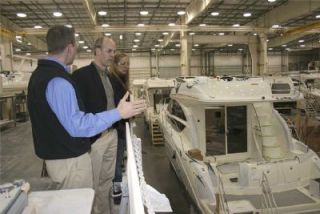ARLINGTON U.S. Rep. Rick Larsen had a busy day in Arlington April 11.
In addition to visiting the Trafton Elementary School and speaking with representatives of the Stillaguamish Tribe of Indians, Larsen spent some time at the Arlington Municipal Airport and its business park.
As a member of the House Transportation and Infrastructure Committee, Larsen cited a study by the Washington State Department of Transportation as evidence of one of the Arlington Airports benefits to the surrounding community.
It showed that this airport puts millions of dollars into our economy and helps support over 300 local jobs, said Larsen, as he toured the facility with Rob Putnam, manager of the Arlington Airport, and shared his congratulations on the federal grant announced this week. Investing federal dollars to keep the airport running safely is a sound investment in this economic engine.
Putnam explained that the Federal Aviation Administration Airport Improvement Program grant would generate more than $1 million for the Arlington Airport.
Well be able to overlay Taxiway Charlie and the Taxiway Charlie connectors, as well as Taxiway Delta and Taxiway connector Delta-3, Putnam said. Well also be able to reconstruct Taxiway connector Delta-2, and add two warm-up aprons to Runway 1129.
Larsen then joined Arlington School District Superintendent Linda Byrnes and ASD Superintendent-Elect Kris McDuffy at the Trafton Elementary School, which received its official national historic recognition in a ceremony April 18.
Before Larsen met with the schools students, Trafton Elementary Principal Ed Aylesworth estimated that the cost of renovating the 1912 schoolhouse could be as low as $750,000, down from previous estimates of as much as $2 million.
This is the first time Ive ever been here, said Larsen to the students, after ringing the school bell. There are two new middle schools and a new high school building since I went to school here. The only school building from my time thats still in use is Trafton. Just by going to school here, youre helping keep history alive.
Larsen met first with the third- through fifth-graders, then with the kindergarten students through second-graders. Larsen explained to the third- through fifth-graders that the most important duties of a Congressman are to vote and write laws, and answered the kindergarten students through second-graders questions about war and terrorist attacks.
We have to concentrate on helping the government of Iraq provide their own security, so that our military can come home, rest and be with their families, Larsen said, when asked about the war. Its a difficult situation, but our men and women in the military are doing a great job.
When asked what would happen if something like 9/11 happened again, Larsen stated that the United States would come together behind its leadership, but added that they would ask, After all weve learned from Sept. 11th, how could something like this happen again?
How did you develop your critical thinking skills? one student asked.
How did you develop that question? Larsen asked in response. Wow!
Larsen returned to the airport business park to tour the facilities of U.S. Marine and Meridian Yachts, citing his involvement with maritime transportation and commerce in Congress.
J.D. Sienicki, chief platform engineer of U.S. Marines parent corporation Brunswick, introduced Larsen to the designers and engineers of their yachts, before Charlie Price, project manager of U.S. Marine, showed Larsen how the yacht parts are assembled, from their hull molds to the cabinetry and upholstery of their cabins.
Sienicki explained to Larsen how the company has successfully tapped into the European and Australian markets, in part by designing its yachts for those overseas markets with larger sun decks than are typically featured on American models. This led to Sienicki mentioning some concerns which he hoped Larsen might be able to address.
Its getting harder to keep the spots for our yachts on the international shipping boats, said Sienicki, who suspected this might be a result of the dollars decline. And transporting those yachts on 172nd is getting to be a big deal, with the increased traffic congestion.
Sienicki also explained that repaving of bridge roads decreases their clearance, which is not noted when truckers attempt to transport yachts on those roads, and lose time and money by failing to make their deliveries.
When Sienicki suggested that a stronger emphasis needs to be placed on training the types of industrial skills that companies like his rely upon, Larsen informed him that the State Legislature has given the green light and financing for a skills center in the Skagit Valley, which will include a satellite Marine Technology Skill Center in Anacortes.
Larsen tours Arlington Airport, schools, businesses
ARLINGTON U.S. Rep. Rick Larsen had a busy day in Arlington April 11.








